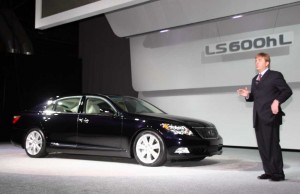
Toyota's Bob Carter, with the Lexus LS600h luxury hybrid
In their desperate bid to win billions of dollars in additional aid, both Chrysler and General Motors are slated to submit updated viability plans to the U.S. Treasury next week — and among those quietly rooting for them is Japanese arch-rival Toyota.
“People look at this industry and see six big silos,” said Bob Carter, Toyota Motor Sales USA vice president, referring to the three American and top three Japanese carmakers, GM, Chrysler , Ford, Toyota, Nissan and Honda, that between them dominate sales in the U.S. “But once you get below that it’s like peeling an onion, it’s all intertwined,” he said.
Not only is Toyota concerned about the fate of the components suppliers its manufacturing operations share with GM and Chrysler, but it also has concerns about its dealer network, Carter said.
“A lot of our dealers also sell General Motors and Chrysler cars,” said Carter. “The whole financial system, supporting the industry is intertwined,” he added, noting that Toyota wants to see GM an d Chrysler regain their footing and thrive. “Strong competitors are good for the business,” insisted Carter.
Toyota is certainly the strongest of competitors for both Chrysler and for GM, which it toppled as global sales leader, in 2008. But things are getting tough for the Japanese giant, as well. The Japanese auto giant announced recently it expects to lose $4 billion in fiscal 2009, and Carter revealed that Toyota has issued a world wide directive to cut costs.
“Toyota’s culture of continuous improvement always focused on cutting costs but how it’s more so. The 10 percent is a global goal,” he said. “In some cases we will take an ax to costs and in others we’ll take a scalpel,” said Carter, noting that Toyota’s U.S. sales operations are now trimming event-oriented marketing, which tends to be very effective but also can be expensive. And it’s cutting incentive trips and other kinds of spending.
The launch of the 4-cylinder Venza was delayed by about three weeks recently because of the production cuts at Toyota’s Camry plant in Kentucky. The hope now is to have inventories reduced to near normal levels by April, he added.
The one thing Toyota isn’t cutting is the advertising and marketing support required to launch the third-generation Prius this spring, Carter said. Toyota plans to spend whatever is necessary to launch the remake of the world’s best-selling hybrd, he said, stressing, “That hasn’t been cut at all.”
The Prius is, in fact, a barometer of Toyota’s problems. During the huge run-up in fuel prices, last Spring, sales topped 21,000 a month, but by December 2008, as gas dipped back below $2 a gallon, Prius sales slipped to barely 6,000. Toyota officials are hoping that at least part of that plunge reflects pent-up demand for the new Prius, but an upturn in fuel prices – and a pickup in the economy, certainly wouldn’t help, either.
